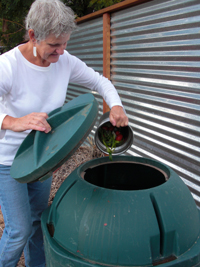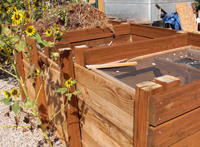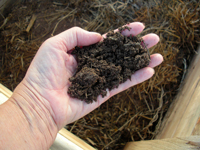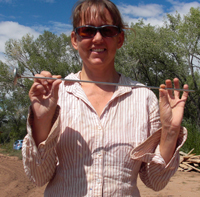Last month’s Sustainable Moab article ended with the observation that to recycle yard and garden matter locally you would have to do it yourself. It is a significant proportion of recycling for the average household. According Utah State University, “In the growing season, 30% or more of the landfill waste is organic yard refuse.” If you live out of the valley bottoms of Moab, Spanish and Castle Valleys you know you could use some humus in your sand and some soil on your rocks. The answer to both problems is composting--turning kitchen scraps and organic yard waste into a rich loamy soil or “black gold” as Rhonda Gotway, the Youth Garden Project farmer, calls it.
 According to gardener and landscaper Michelle Wiley, there are two basic ways to build a compost pile. The faster of the two is to collect materials separately and build your pile all at once, layering materials in the optimum proportions to generate maximum heat in the pile. A compost thermometer is handy so you know when your pile has reached the desired 80 degrees--usually about 12 days. At this point, Michelle suggests turning the pile to give the microbes more oxygen, so they can get to work again. A pitch fork is the best tool for this job. The pile may now reach temperatures of 150 to 160 degrees. To generate temperatures of 120 degrees a pile must be three feet on a side. By the third or fourth turning and falling off of the temperature the debris should be humus.
According to gardener and landscaper Michelle Wiley, there are two basic ways to build a compost pile. The faster of the two is to collect materials separately and build your pile all at once, layering materials in the optimum proportions to generate maximum heat in the pile. A compost thermometer is handy so you know when your pile has reached the desired 80 degrees--usually about 12 days. At this point, Michelle suggests turning the pile to give the microbes more oxygen, so they can get to work again. A pitch fork is the best tool for this job. The pile may now reach temperatures of 150 to 160 degrees. To generate temperatures of 120 degrees a pile must be three feet on a side. By the third or fourth turning and falling off of the temperature the debris should be humus.
You can screen it at this point and throw back any chunks that need to break down further, sort of the inverse of throwing back the little fish. Michelle recommends testing your compost by smelling a handful. It should smell like good, sweet earth. The more advanced test is to put some in a covered jar over night and then give it the sniff test. If it passes, it’s ready for your house plants, garden or lawn.
The other method of building a pile is as you go. This is my preferred method since it is easier. I have three bins four by four by three feet. The first one gets all the garden and yard refuge, table scraps, old straw and lawn clippings as I “harvest” them. I add some garden dirt occasionally which is amended with last year’s compost. I don’t know if the science is sound, but if it works for sour dough starter, why not compost?
 After three months, or whenever I need more room for garden refuge, I turn this pile into the second box, assuming it is mostly empty. If it isn’t, then I turn the second into the third. Because the material shrinks as the microbes, insects and worms feed on it, I only empty the third bin once a year when I dig it into my vegetable garden. Turning the pile from one bin to the next puts the newest material on the bottom where it gets the warmest and the most worms are feeding.
After three months, or whenever I need more room for garden refuge, I turn this pile into the second box, assuming it is mostly empty. If it isn’t, then I turn the second into the third. Because the material shrinks as the microbes, insects and worms feed on it, I only empty the third bin once a year when I dig it into my vegetable garden. Turning the pile from one bin to the next puts the newest material on the bottom where it gets the warmest and the most worms are feeding.
 This second method doesn’t rely as much on high heat as on time and worms or vericulture. I have red worms whose distant ancestors I acquired from a neighbor several years ago. Earth worms work just as well. The worm castings are very rich in nutrients. According to an online supplier of red worms their castings are seven times richer in phosphates, five times richer in nitrogen and eleven times richer in potash than the average lawn soil.
This second method doesn’t rely as much on high heat as on time and worms or vericulture. I have red worms whose distant ancestors I acquired from a neighbor several years ago. Earth worms work just as well. The worm castings are very rich in nutrients. According to an online supplier of red worms their castings are seven times richer in phosphates, five times richer in nitrogen and eleven times richer in potash than the average lawn soil.
Another advantage of vericulture is that it is effective in small batches and can be easily done in the garage, basement, or even kitchen. I have a friend who lives in the heart of San Francisco. Using earthworms in a commercial, recycled plastic compost bin and feeding them yard debris and household waste, he makes rich, black soil with no odor in one tidy container.
 In Moab’s desert climate, you have to add water to your piles. I had one of those plastic, slat-sided boxes years ago. After three years with no water added, there was almost no change in the contents--eggshells still looked like eggshells, corn cobs like large Anasazi corn cobs and corrugated cardboard like, well, corrugated cardboard. All of these materials will break down with a little added moisture--damp but not soggy.
In Moab’s desert climate, you have to add water to your piles. I had one of those plastic, slat-sided boxes years ago. After three years with no water added, there was almost no change in the contents--eggshells still looked like eggshells, corn cobs like large Anasazi corn cobs and corrugated cardboard like, well, corrugated cardboard. All of these materials will break down with a little added moisture--damp but not soggy.
To maintain a good carbon:nitrogen balance, these figures from Utah State University might be useful--garden refuse and kitchen scraps have approximately a 25:1 ratio, manure a 20-50:1, grass clippings 15-30:1, straw and leaves anywhere from 50-120:1, and sawdust is as high as 500:1. The issue with high carbon materials such as sawdust is that they rob the pile of nitrogen while they are breaking down. Another problem with sawdust is that it may come from glued woods like plywood or from chemically treated woods. The best plant sources of nitrogen are lawn clippings and alfalfa. The wide variation of nitrogen in manure is from horse on the low end with cow, sheep, and rabbit in the middle to fowl on the high or hot end of the scale.
While sawdust is iffy, meat products, milk products, fish parts, eggs, grease and oils are definite no’s. Besides creating odors, they will attract skunks, rats and other pests. Another no for the compost is pet feces because they can contain parasites and germs transferrable to people.
As with so many things in life, composting requires moderation and balance--moderate amounts of moisture, some oxygen, and a balance of carbon and nitrogen. While the technical details can be fun, the basics are simple and rewarding. There are probably thousand of microbes working away right now in your neighborhood converting waste to Rhonda’s black gold.
 According to gardener and landscaper Michelle Wiley, there are two basic ways to build a compost pile. The faster of the two is to collect materials separately and build your pile all at once, layering materials in the optimum proportions to generate maximum heat in the pile. A compost thermometer is handy so you know when your pile has reached the desired 80 degrees--usually about 12 days. At this point, Michelle suggests turning the pile to give the microbes more oxygen, so they can get to work again. A pitch fork is the best tool for this job. The pile may now reach temperatures of 150 to 160 degrees. To generate temperatures of 120 degrees a pile must be three feet on a side. By the third or fourth turning and falling off of the temperature the debris should be humus.
According to gardener and landscaper Michelle Wiley, there are two basic ways to build a compost pile. The faster of the two is to collect materials separately and build your pile all at once, layering materials in the optimum proportions to generate maximum heat in the pile. A compost thermometer is handy so you know when your pile has reached the desired 80 degrees--usually about 12 days. At this point, Michelle suggests turning the pile to give the microbes more oxygen, so they can get to work again. A pitch fork is the best tool for this job. The pile may now reach temperatures of 150 to 160 degrees. To generate temperatures of 120 degrees a pile must be three feet on a side. By the third or fourth turning and falling off of the temperature the debris should be humus.  After three months, or whenever I need more room for garden refuge, I turn this pile into the second box, assuming it is mostly empty. If it isn’t, then I turn the second into the third. Because the material shrinks as the microbes, insects and worms feed on it, I only empty the third bin once a year when I dig it into my vegetable garden. Turning the pile from one bin to the next puts the newest material on the bottom where it gets the warmest and the most worms are feeding.
After three months, or whenever I need more room for garden refuge, I turn this pile into the second box, assuming it is mostly empty. If it isn’t, then I turn the second into the third. Because the material shrinks as the microbes, insects and worms feed on it, I only empty the third bin once a year when I dig it into my vegetable garden. Turning the pile from one bin to the next puts the newest material on the bottom where it gets the warmest and the most worms are feeding. This second method doesn’t rely as much on high heat as on time and worms or vericulture. I have red worms whose distant ancestors I acquired from a neighbor several years ago. Earth worms work just as well. The worm castings are very rich in nutrients. According to an online supplier of red worms their castings are seven times richer in phosphates, five times richer in nitrogen and eleven times richer in potash than the average lawn soil.
This second method doesn’t rely as much on high heat as on time and worms or vericulture. I have red worms whose distant ancestors I acquired from a neighbor several years ago. Earth worms work just as well. The worm castings are very rich in nutrients. According to an online supplier of red worms their castings are seven times richer in phosphates, five times richer in nitrogen and eleven times richer in potash than the average lawn soil. In Moab’s desert climate, you have to add water to your piles. I had one of those plastic, slat-sided boxes years ago. After three years with no water added, there was almost no change in the contents--eggshells still looked like eggshells, corn cobs like large Anasazi corn cobs and corrugated cardboard like, well, corrugated cardboard. All of these materials will break down with a little added moisture--damp but not soggy.
In Moab’s desert climate, you have to add water to your piles. I had one of those plastic, slat-sided boxes years ago. After three years with no water added, there was almost no change in the contents--eggshells still looked like eggshells, corn cobs like large Anasazi corn cobs and corrugated cardboard like, well, corrugated cardboard. All of these materials will break down with a little added moisture--damp but not soggy.